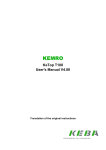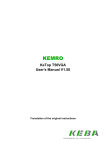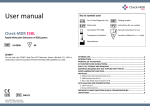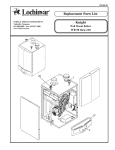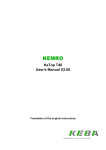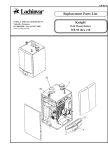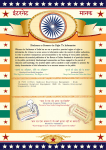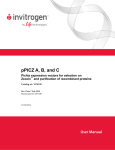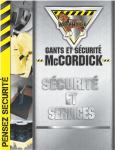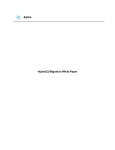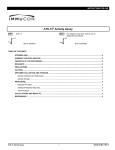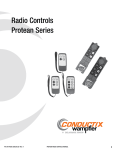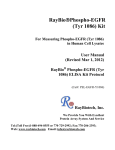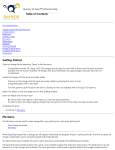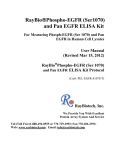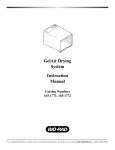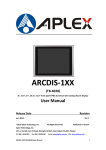Download ReliaBLOT®
Transcript
ReliaBLOT ® WesternBlotKit 10x8cm,12%,12well CatNo.WB102‐01212K UserManual The Polyclonal Antibody Specialists www.bethyl.com 1-800-338-9579 Table of Contents Introduction.......................................................................................................... 3 Kit Components ................................................................................................... 3 Other Reagents Needed........................................................................................ 4 Component Specifications ................................................................................... 4 ReliaBLOT® Precast SDS-PAGE Gel Cassettes .............................................. 4 ReliaBLOT® LDS Sample Buffer (4X) ........................................................... 4 ReliaBLOT® DTT Reducing Agent ................................................................. 4 ReliaBLOT® Pre-stained Protein Marker......................................................... 5 ReliaBLOT® Running Buffer (20X) ................................................................ 5 ReliaBLOT® Transfer Buffer (10X) ................................................................ 6 ReliaBLOT® Nitrocellulose Membrane/Filter Sandwiches ............................. 6 ReliaBLOT® HRP-Conjugated Anti-Rabbit Secondary Antibody................... 6 ReliaBLOT® Chemiluminescent HRP Substrate ............................................. 6 Suggested Protocols for SDS-PAGE and Western Blot....................................... 7 Buffer and Reagent Preparation ....................................................................... 7 ReliaBLOT® Running Buffer ....................................................................... 7 ReliaBLOT® Transfer Buffer ....................................................................... 7 ReliaBLOT® DTT Reducing Agent ............................................................. 7 TBST............................................................................................................ 8 Blocking Buffer ........................................................................................... 8 Preparation of Protein/Lysate Sample .............................................................. 8 Electrophoresis in ReliaBLOT® SDS-PAGE Gel ............................................ 8 Transfer to Nitrocellulose ................................................................................ 9 Western Blot .................................................................................................. 10 Development .................................................................................................. 10 Troubleshooting ............................................................................................. 12 2 Introduction The ReliaBLOT® Western Blot Kit from Bethyl Laboratories conveniently provides the major reagents needed to perform standard western blot assays. The kit provides enough reagents to run five mini-gels and western blot assays. The components provided for SDS-PAGE and gel transfer are compatible with most mini-gel electrophoresis and blotting modules that accept an external gel cassette size of 10 X 8 cm (e.g. Bio-Rad Mini-PROTEAN® Cell and Mini TransBlot® modules). For western blot, an HRP-conjugated Anti-rabbit secondary antibody is provided for the detection of primary antibodies made in rabbit hosts. Kit Components The ReliaBLOT® Kit components, quantities, and storage conditions are as follows: Component ReliaBLOT® Precast SDS-PAGE Gel Cassettes (4-8%, 4-12%, 4-20% gradient, or 12%, 12-well, 10 X 8 cm) ReliaBLOT® LDS Sample Buffer (4x) ReliaBLOT® DTT Reducing Agent Quantity 5 each Storage 2 - 8oC 2.0 ml 0.15 g ReliaBLOT® Pre-stained Protein Marker 0.1 ml ReliaBLOT® Running Buffer (20X) ReliaBLOT® Transfer Buffer (10X) ReliaBLOT® Nitrocellulose Membrane/Filter Sandwiches (0.2 µm) ReliaBLOT® HRP-conjugated Antirabbit Secondary Antibody ReliaBLOT® Chemiluminescent HRP Substrate (A and B) 125 ml 500 ml 5 each Room Temperature 2 - 8oC OR -20oC (after reconstitution) -20oC (long-term) OR 2 - 8oC (up to 3 mos.) Room Temperature Room Temperature Room Temperature 0.05 ml 2 - 8oC 6.0 ml each 2 - 8oC 3 Other Reagents Needed o o o o o o Methanol Primary Antibodies (made in rabbit hosts) Blocking Buffer (e.g. non-fat dried milk or BSA in TBS with Tween) Wash Buffer – Tris Buffered Saline with Tween (TBST) Ultrapure Water Distilled or Deionized Water Component Specifications ReliaBLOT® Precast SDS-PAGE Gel Cassettes External size of 10 cm (W) X 8 cm (L) X 1 cm (gel matrix thickness) Full length resolving gradient gel (4-8%, 4-12%, 4-20% or 12%) Red stacking gel for easy well identification High capacity 12-well; load up to 25 µl per well ReliaBLOT® LDS Sample Buffer (4X) ReliaBLOT® LDS sample buffer (4X) is formulated according to the table below: Tris-HCL Tris-base LDS Glycerol EDTA Coomassie Brilliant Blue G250 Phenol Red [4X] 424 mM 564 mM 8% 40% 2.04 mM 0.88 mM 0.72 mM ReliaBLOT® DTT Reducing Agent Used as a reducing agent for preparation of protein samples for SDSPAGE. Final concentration after reconstitution is 1.0 M Dithiothreitol (10X solution) 4 ReliaBLOT® Pre-stained Protein Marker 10 recombinant proteins with apparent molecular weights ranging from 7.6 kDa to 195 kDa The 28 kDa and 71 kDa markers appear orange for easy identification. The marker is ready to load; no need to boil. The recommended load volume is 5 – 8 µl of the protein marker per well. The average apparent molecular weights (kDa) for the ReliaBLOT® Pre-stained Protein Markers in the ReliaBLOT® SDS-PAGE (TrisGlycine) system are shown. 8 µl of ReliaBLOT® Pre-stained Protein Marker was loaded on the indicated ReliaBLOT® SDS gel, electrophoresed for 1 hour at 150 volts, and transferred to nitrocellulose for 2 hours at 20 volts. ReliaBLOT® Running Buffer (20X) ReliaBLOT® Running Buffer (20X) is formulated according to the table below: Tricine (free base) Tris (free base) SDS Sodium Bisulfite 20X 0.8 M 1.2 M 2.0% 50 mM 5 ReliaBLOT® Transfer Buffer (10X) ReliaBLOT® Transfer Buffer (10X) is formulated according to the table below: Glycine Tris (free base) SDS 10X 1.92 M 0.25 M 1% ReliaBLOT® Nitrocellulose Membrane/Filter Sandwiches 100 % nitrocellulose membrane Pre-cut and assembled into a membrane and filter sandwich. 0.2 um pore size 8.3 X 7.3 cm dimensions ReliaBLOT® HRP-Conjugated Anti-Rabbit Secondary Antibody HRP (horseradish peroxidase) conjugated goat immunoglobulin G (IgG) protein (1mg/ml) Supplied in phosphate buffered saline (PBS) containing 0.2% BSA and 0.1% Pro-Clean 400 For use with primary antibodies made in rabbit. Reacts specifically with rabbit IgG and with light chains common to other rabbit immunoglobulins. Recommended dilutions for western blot and detection by chemiluminescence are in the range of 1:10,000 to 1:20,000. ReliaBLOT® Chemiluminescent HRP Substrate A two-component enhanced chemiluminescent substrate for detecting HRP on immunoblots (components “A” and “B”). Working Solution is prepared by mixing equal parts of component “A” and “B”. Only 2 ml of Working Solution needed per membrane Working Solution is stable for 24 hours at room temperature. After incubation of blot with Working Solution, chemiluminescent signal may continue for up to 8 hours but will decrease with time. 6 Suggested Protocols for SDS-PAGE and Western Blot Buffer and Reagent Preparation ReliaBLOT® Running Buffer About 300 ml of Running Buffer is needed to run one gel or a pair of gels in a mini-gel system (e.g. Bio-Rad Mini-PROTEAN® Cell modules). 20X Running Buffer 15 ml Distilled water 285 ml Total volume 300 ml o *Store for up to 1 week at 2-8 C. ReliaBLOT® Transfer Buffer NOTE: It is recommended to prepare the 1X Transfer Buffer the same day of the transfer. Approximately 950 ml is needed to transfer one gel or a pair of gels in a tank system (e.g. Bio-Rad Mini Trans-Blot® modules). 10X Transfer Buffer 100 ml Methanol 200 ml Distilled Water 700 ml Total volume 1000 ml o *Chill to 2-8 C before use. ReliaBLOT® DTT Reducing Agent Reconstitute the DTT by adding 1.0 ml of ultrapure water. Aliquot (100 µl each) into microcentrifuge tubes and store at -20oC. 7 TBST Tris (free base) NaCl Tween-20 Distilled water to 6.1 g 8.1g 500 µl 1.0 L [50 mM] [138 mM] [0.05 %] -Adjust pH to 8.0 with HCL -Store at 4-25o C. Blocking Buffer NOTE: Blocking buffer should be made fresh and dissolved well. Carnation non-fat dry milk TBST Total volume 2.5 g 50 ml 50 ml Preparation of Protein/Lysate Sample For each well, sample volume should not exceed 25 µl. The mass of sample required for detection by western blot should be empirically determined. Typically 10 to 50 µg of cell lysate in sample buffer is loaded per well. 1. 2. 3. 4. 5. 6. 7. For each sample, aliquot 10 to 50 µg of cell lysate in a sterile microfuge tube (5-25 µl). Add 4X LDS sample buffer to the sample to achieve a 1X concentration of LDS sample buffer. Add 10X DTT to achieve a final concentration of 1X DTT. Mix well. Heat samples at 95o C for 5 minutes. Quick spin condensate if needed. Load immediately on ReliaBLOT® SDS-PAGE gel as described below. Electrophoresis in ReliaBLOT® SDS-PAGE Gel 1. 2. 3. Cut open the package that contains the gel cassette and drain away the buffer. Rinse the wells with distilled water. Place the gels on the buffer core and assemble the electrophoresis cell according to the manufacturer’s directions (e.g. Bio-Rad MiniPROTEAN® Cell modules). 8 4. 5. 6. 7. Fill the inner core chamber with fresh 1X running buffer to cover the sample wells (about 125 ml). If there are no leaks, fill the outer chamber with the remaining running buffer. Using a pipette (1 ml volume) flush the wells using the 1x running buffer from the inner chamber. Load the prepared samples using a Hamilton syringe or a pipettor fitted with gel loading tips. Run the gels at 150V until the dye front reaches the bottom of the gel (approximately 60 minutes). Transfer to Nitrocellulose 1. 2. 3. 4. 5. Use gloves and forceps to handle the nitrocellulose membranes. For each gel to be transferred, remove and separate a membrane/filter paper sandwich from the blue interleaf paper. Discard the blue interleaf paper. In a shallow tray, pre-wet the nitrocellulose membrane and blotting filter paper in 1X Transfer Buffer for at least 5 minutes. In a shallow tray, soak blotting pads in 1X Transfer Buffer Open the gel cassette by inserting a small metal spatula or gel knife into the gap between the plates and gently twisting the plates apart. The gel will stick to one plate. Note the orientation of the gel and assemble the blotting sandwich as described in the manufacturer’s instructions for the blotting module (e.g. Bio-Rad Mini Trans-Blot® module) or according to figure 1. Figure 1. Assembly of the Gel Sandwich. Proteins will migrate toward the anode; therefore, in the sandwich, the membrane should be closest to the anode. 9 6. 7. 8. Place the cassette into the transfer module. Fill the tank to the appropriate level with cold 1X Transfer Buffer. Transfer conditions will depend on the type of blotting module used. Refer to the manufacturer’s recommendations for transfer running time and voltage. 9. When the transfer is complete, remove the membrane from the blotting module/sandwich and place the membrane in a dish of blocking buffer (5% non-fat dry milk in TBST; the buffer should sufficiently cover the membrane). 10. Discard the filter paper. Western Blot 1. 2. 3. 4. 5. 6. 7. 8. Incubate the membrane in blocking buffer for 1 hour on a rocking platform shaker. Dilute the primary antibody in 15 ml of blocking buffer (5% nonfat dry milk in TBST). For best results, the optimal dilution of antibody should be empirically determined. Pour off the blocking buffer from the membrane and replace with the diluted primary antibody mixture. Incubate the membrane in diluted primary antibody for two hours to overnight with gentle rocking at room temperature. Wash the membrane three times, 10 minutes each time in TBST. Dilute the HRP-conjugated Anti-rabbit Secondary Antibody in 15 ml of 5% non-fat dry milk in TBST. For best results, the optimal concentration of the secondary HRP conjugated antibody should be empirically determined. The recommended range for dilution is 1:10,000 to 1:20,000. Incubate the membrane in diluted HRP-conjugated Anti-rabbit Secondary Antibody for 60 minutes on a rocker platform. Wash as directed in step 5. Development 1. 2. Make a Working Solution of the Chemiluminescent Substrate by mixing 1 ml of component “A” and 1 ml of component “B”. Two mls of Working Solution will be needed for each membrane. Use clean serological pipettes to pipette the components into a 15 ml conical tube. Using forceps remove the membrane from the last wash and blot the edge on a paper towel to remove excess wash buffer, and place the membrane on a clean surface. 10 3. 4. 5. 6. Pipette 2 ml of the activated substrate solution onto the entire surface of the membrane and incubate at room temperature for 5 minutes. Using forceps lift the membrane and drain off substrate. Blot the edge of the membrane on a paper towel to remove excess substrate. Place the membrane in plastic membrane protector (e.g. plastic film wrap or a page protector). Smooth out bubbles between the membrane and the plastic protector. Expose the membrane to film or a charged-coupled device (CCD) camera. Exposure times will vary in length and will need to be empirically determined. 11 Troubleshooting Problem No Signal Cause The primary antibody may not be compatible with the secondary antibody provided in the kit. Primary antibody is too dilute. Insufficient binding time Insufficient antigen The lysate/protein sample is degraded. Solution Primary antibodies must be made in rabbit hosts. 1. Increase concentration (lower the dilution) of the primary antibody. 2. Titrate the primary antibody to empirically determine optimal antibody dilution to achieve the best signal/noise ratio. Incubate primary antibody overnight at 2-8oC or room temperature. Load at least 20-50 ug of protein. 1. 2. 3. 4. Inadequate expression of the protein target in the lysate/sample 1. 2. 3. 4. Poor transfer of protein to membrane 1. 2. 3. Store lysates and protein samples at -80 oC Avoid multiple freezethawing. Keep protein samples on ice. Check lysate integrity by probing the blot with a control antibody (e.g. antiactin) or staining the membrane with Ponceau S. Use a positive control lysate in which the endogenous target is known to be expressed at relatively abundant levels. Enrich the target by isolating nuclear, membrane, or mitochondrial extracts. Enrich the target by performing an immunoprecipitation. Examine the literature for treatments that may induce endogenous expression of the target. Check that all of the colored markers of the protein standard have been transferred to the membrane. Monitor transfer efficiency by staining the gel with Coomassie® blue or staining the membrane with Ponceau S. Use only fresh transfer buffer. 12 Problem No Signal (continued) Cause Poor transfer of protein to membrane (continued) Solution 4. 5. 6. Target is masked by the blocking solution 1. 2. Chemiluminescent detection 3. 1. 2. 3. High membrane background or “dirty” blot Insufficient blocking 1. 2. 3. 4. 5. 6. Primary antibody 1. 2. Small proteins (>20 kDa) may transfer through the membrane. Shorten transfer time or re-evaluate the gel percentage and buffer system used. Large proteins (> 200 kDa) may require an overnight transfer at low voltage/ 28oC. Exceptionally large proteins (>300 kDa) may require the use of a tris-acetate gel and buffer system. Re-evaluate the gel percentage and buffer system used. Experiment with alternatve blocking buffers (e.g. BSA). Lower the percentage of milk (e.g. 1%) Block for less time. Confirm that the working solution was made properly. Use freshly made working solution. Sodium azide is an inhibitor of HRP. Do not use sodium azide as a preservative in buffers. 5% non-fat dry milk in TBS or PBS with Tween20 (0.05%) works well to block membrane background. Block membranes for at least 1 hr at room temperature. Use blocking buffer as the diluent for the primary antibody. Ensure good coverage of the membrane with blocking solution during blocking and antibody incubation. Ensure that the dried milk is fully dissolved in the blocking buffer Blocking buffer should be fresh. Decrease the concentration (increase the dilution) of the primary antibody. Titrate the primary antibody to empirically determine the 13 Problem High membrane background or “dirty” blot (continued) Cause Solution Primary antibody (continued) 3. 4. Insufficient washing 1. 2. Multiple bands or “lane background” Insufficient blocking 3. 1. 2. 3. Primary antibody 1. 2. 3. Secondary antibody 1. 2. 3. optimal antibody dilution to achieve the best signal/noise ratio. The nature of some primary antibodies may always result in slight membrane background. The stock solution of the primary or secondary antibodies contains aggregates. Microfuge the antibodies at 14,000 X G for 10 minutes at 4oC. After primary and secondary antibody incubation, perform at least three 10-minute washes. Include detergent (0.05% Tween20) in the TBS or PBS wash buffer. Increase number of washes. 5% non-fat dry milk in TBS or PBS with Tween20 (0.05%) works well to block non-specific bands and lane background. Block membranes for at least 1 hr at room temperature. Use blocking buffer as the diluent for the primary antibody. Decrease the concentration (increase the dilution) of the primary antibody. Titrate the primary antibody to empirically determine the optimal antibody to achieve the best signal/noise ratio.. Use affinity purified antibody. Decrease the concentration (increase the dilution) of the secondary antibody. Incubate secondary antibody for 1 hour. Titrate the secondary antibody to empirically determine the optimal antibody dilution to achieve the best signal/noise ratio. 14 Problem Multiple bands or “lane background” (continued) Cause Empirically determine the optimal amount of lysate to load per lane to achieve the best signal to noise/ratio. The lysate is degraded 1. Cross-reacting proteins Modified proteins Protein multimers Ghost bands (reverse/white bands) Primary antibody concentration too high. Secondary antibody concentration too high. Uneven bands or “smiling” bands across gel Solution Too much lysate/protein sample loaded into the lane. Gel was run too hot or too fast. Store lysates and protein samples at -80 oC 2. Avoid multiple freezethawing. 3. Keep protein samples on ice. Primary antibodies may crossreact with off-target proteins, even under optimal conditions. The target protein may be present in multiple modified forms (e.g. phosphorylation, ubiquitination, glycosylation) or as different splice variants or isoforms. The protein target may form multimers. Boil samples in SDS or LDS sample buffer before loading. Titrate the primary antibody to empirically determine the optimal antibody dilution to achieve the best signal/noise ratio. Titrate the secondary antibody to empirically determine the optimal antibody dilution to achieve the best signal/noise ratio. 1. Run the gel in the cold room or on ice. 2. Slow down the run by lowering the voltage. Warranty Products are warranted by Bethyl Laboratories, Inc. to meet stated product specifications and to conform to label descriptions when used, handled and stored according to instructions. Unless otherwise stated, this warranty is limited to six months from date of sale. Bethyl Laboratories sole liability for the product is limited to replacement of the product or refund of the purchase price. Bethyl Laboratories products are supplied for research applications. They are not intended for medicinal, diagnostic or therapeutic use. The products may not be resold, modified for resale or used to manufacture commercial products without prior written approval from Bethyl Laboratories, Inc. 15 Related Products Description ReliaBLOT® Western Blot Kit 4-8%, 10 x 10 cm ReliaBLOT® Western Blot Kit 4-12%, 10 x 10 cm ReliaBLOT® Western Blot Kit 4-20%, 10 x 10 cm ReliaBLOT® Western Blot Kit 12%, 10 x 10 cm ReliaBLOT® Western Blot Kit 4-8%, 10 x 8 cm ReliaBLOT® Western Blot Kit 4-12%, 10 x 8 cm ReliaBLOT® Western Blot Kit 4-20%, 10 x 8 cm ReliaBLOT® Western Blot Kit 12%, 10 x 8 cm ReliaBLOT® SDS-PAGE Gels 4-8%, 10 x 10 cm ReliaBLOT® SDS-PAGE Gels 4-12%, 10 x 10 cm ReliaBLOT® SDS-PAGE Gels 4-20%, 10 x 10 cm ReliaBLOT® SDS-PAGE Gels 12%, 10 x 10 cm ReliaBLOT® SDS-PAGE Gels 4-8%, 10 x 8 cm ReliaBLOT® SDS-PAGE Gels 4-12%, 10 x 8 cm ReliaBLOT® SDS-PAGE Gels 4-20%, 10 x 8 cm ReliaBLOT® SDS-PAGE Gels 12%, 10 x 8 cm ReliaBLOT® LDS Buffer (4X) ReliaBLOT® Running Buffer (20X) ReliaBLOT® Transfer Buffer (10X) ReliaBLOT® Nitrocellulose Membrane Filter Sandwiches (7.5 x 8.3 cm) ReliaBLOT® DTT Reducing Agent 10X ReliaBLOT® Prestained Protein Marker ReliaBLOT® Chemiluminescent HRP Substrate ReliaBLOT® IP/Western Blot Reagents Goat anti-Rabbit IgG-h+l HRP Goat anti-Mouse IgG-h+l HRP Size Catalog No. 1 kit WB101-40812K 1 kit WB101-41212K 1 kit WB101-42012K 1 kit WB101-01212K 1 kit WB102-40812K 1 kit WB102-41212K 1 kit WB102-42012K 1 kit WB102-01212K 10 gels WB101-40812G 10 gels WB101-01212G 10 gels WB101-42012G 10 gels WB101-41212G 10 gels WB102-40812G 10 gels WB102-01212G 10 gels WB102-42012G 10 gels 10 ml 500 ml 500 ml WB102-41212G WB104-10 WB105-500 WB106-500 20/pk 1 ml 600 ul WB107-20 WB108 WB103-600 110 ml 20 blots 1 ml at 1 mg/ml 1 ml at 1 mg/ml WB110 WB120 A120-101P A90-116P 16
















